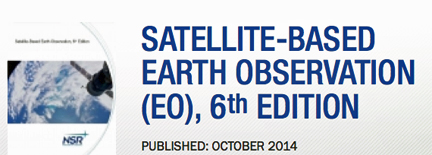
[SatNews] As the New Year brings a whole set of expectations, one of the key measurements will be the expectation that commercially-available very high resolution imagery will help EO users ‘see more’.
And more nations are likely to assess this new type of satellite imagery to lower their limits on what users can see.
For the foreseeable future, the very high resolution market is likely be ‘reserved’ for the NGA under the EnhancedView contract and perhaps other U.S. Government agencies. But down the road, DigitalGlobe, which received a boost of 20 percent in imaging capacity with its newest satellite, is likely to count other Allied nations as customers of very high resolution data. This will be the first full year that EO imagery is offered by DigitalGlobe’s WorldView-3 satellite, and other governments may feel pressure to drop their barriers on resolution if the market turns out to be a success early on.
Israel could be the first country outside the U.S. to do so with ImageSat International’s Eros series satellites likely to put a new twist in the very high resolution market. It has a lighter, cheaper platform with flexible onboard camera look angles and at about 350 kg (770 lbs), offers a large savings on manufacturing and launch costs. It certainly will not offer the sophistication level of an NGA-requirement based Worldview-3, which will have 31 cm resolution data (not resampled), but could cater to a lot of nations in developing regions that want better than 50 cm data. In fact, the Israeli manufacturer of the Eros platform, IAI was quoted in Space News last fall stating they’re “… headed to 25 centimeter imagery”.
And even if the market is still nascent, it will take a prominent role for the EO market as erosion of prices at the lower end of the market dampens expectations. NSR’s recently released Satellite-Based Earth Observation, 6th Edition report shows that very-high resolution imagery will slowly be adopted and could reach close to 10 percent of the EO data market revenues by 2023. The decrease in market share of medium resolution and high-resolution optical data will be the result of both decreases in per/km2 pricing and a migration to very-high resolution data.
In the race for providing clearer sight of targets on the ground, be it for military or commercial purposes, satellite-based very-high resolution imagery is a formidable tool to address the growth in competition from Earth imaging aerial manned and unmanned platforms. But it will not replace it. Rather, it will act as a complement even if its capabilities give satellite a strong competitive edge: more frequent revisit, operations under any weather, expanded distribution networks and diversification of imaging sources (optical, SAR, and eventually hyperspectral).

2015 signifies an inflection point in the EO market. The impact of very high resolution imagery on the satellite-based Earth Observation market will start to be felt this year, and the expectations are high due to increasing competition from both commercial and government-owned satellites. As more customers want imagery with finer detail, the next twelve months will tell us if seeing more will meet their expectations and help lower the barrier such that more EO satellites could provide clearer views of the Earth in the years to come.
Story by Claude Rousseau, Research Director, NSR France

